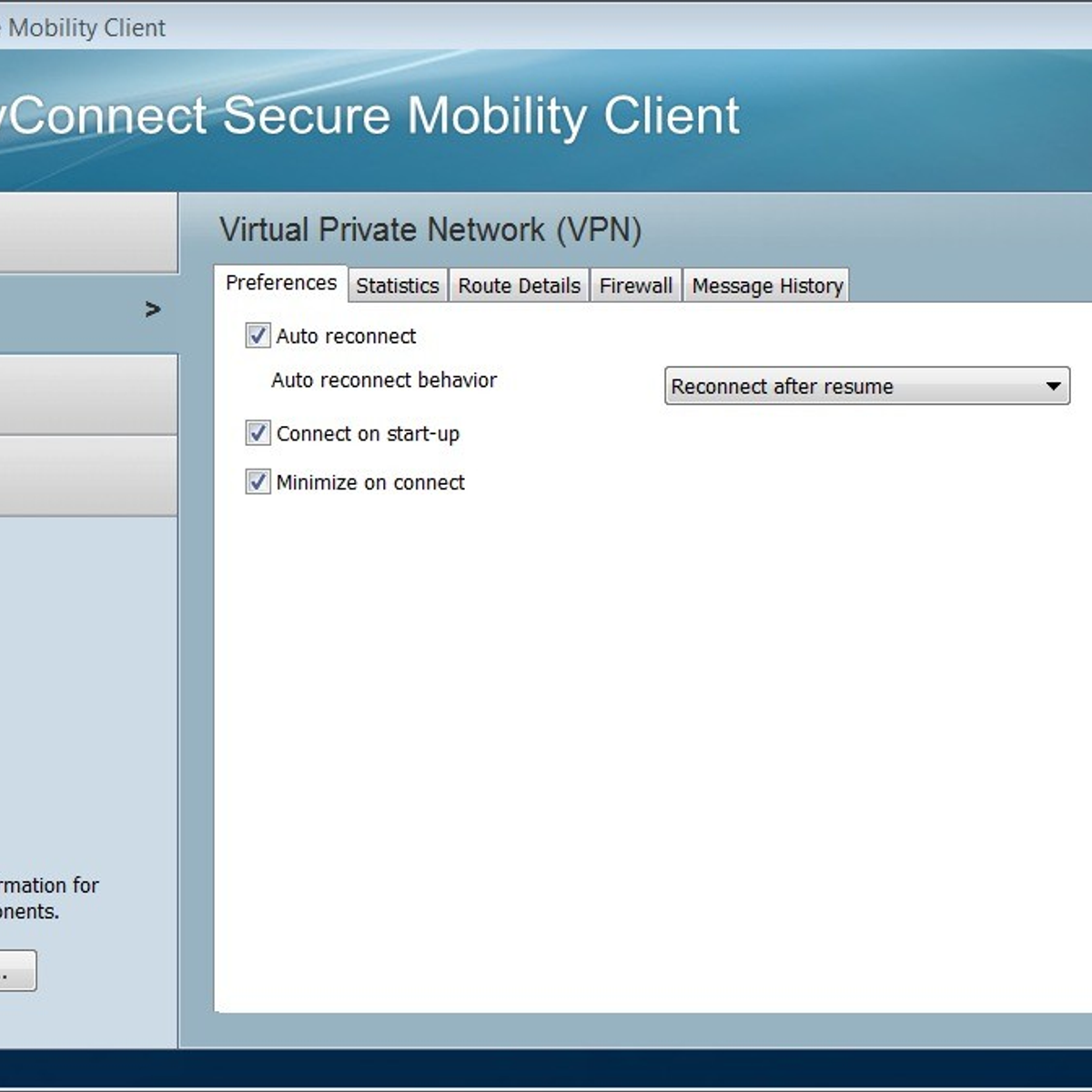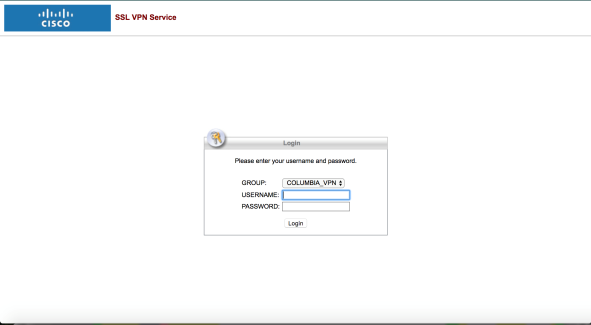Cisco AnyConnect 4.9 MR2 will be released between September 14, 2020, and September 21, 2020, f or all customers across all production release tracks who have the AnyConnect Cloud auto-update feature enabled in settings. Customers not using cloud upgrade can deploy at any time. Note: There is no Windows release for 4.9 MR2. This update automatically updates AnyConnect, including the VPN.

Objective
- Troubleshooting and Session Logs for AnyConnect for VPN for Mac OS X. Troubleshooting Logs. Export information from the VPN client to help locate and isolate a connection problem. From the Applications folder, click the AnyConnect VPN icon to open the user interface. A new pane labeled Cisco AnyConnect VPN Client will pop up.
- Oct 25, 2016 Cisco anyconnect 4.3.03086 on mac OS 10.12.x I would like to ask you if the problem with recognising of built-in firewall is solved? I've read hostscan support chart for anyconnect 4.3.03086 and mac os 10.12.x built-in firewall should be recognised as turned on.
- Follow the instructions below to download, install and connect the AnyConnect Secure Mobility Client on your Mac computer (OS X 10.9 or newer) to the new MSU VPN. Go to your Applications folder, open the Cisco folder and then click the Cisco AnyConnect Secure Mobility Client.

Cisco Anyconnect For Mac Os X Download
The objective of this document is to show you the details about the supported operating systems (Windows, Linux, Mac) of the Cisco AnyConnect Secure Mobility Client and their requirements.
The Cisco AnyConnect Secure Mobility Client, also known as the Cisco AnyConnect VPN Client, is a software application for connecting to a Virtual Private Network (VPN) that works on various operating systems and hardware configurations. This software application makes it possible for remote resources of another network become accessible as if the user is directly connected to the network, but in a secure way. Cisco AnyConnect Secure Mobility Client provides an innovative way to protect mobile users on computer-based or smart-phone platforms, providing a more seamless, always-protected experience for end users, and comprehensive policy enforcement for an IT administrator.
For additional information on AnyConnect licensing on the RV340 series routers, see this article
Software Version
- AnyConnect Secure Mobility Client 4.4 | (Download latest)
AnyConnect Supported Operating Systems and Requirements
AnyConnect Support for Microsoft Windows
Windows Operating Systems
- Windows 7 Special Pack (SP) 1
- Windows 8
- Windows 8.1
- Windows 10 x86 (32-bit) and x64 (64-bit)
Windows Requirements
- Pentium class processor or greater
- 100 MB hard disk space
- Microsoft Installer version 3.1
- Upgrading to Windows 8.1 from any previous Windows release requires you to uninstall AnyConnect, and reinstall it after your Windows upgrade is complete.
- Upgrading from Windows XP to any later Windows release requires a clean install since the Cisco AnyConnect Virtual Adapter is not preserved during the upgrade. Manually uninstall AnyConnect, upgrade Windows, and then reinstall AnyConnect manually or via WebLaunch.
- To start AnyConnect with WebLaunch, you must use the 32-bit version of Firefox 3.0+ and enable ActiveX or install Sun JRE 1.4+.
- ASDM version 7.02 or higher is required when using Windows 8 or 8.1

AnyConnect Support for Linux
Linux Operating Systems
- Linux Red Hat 6
- Linux Red Hat 7
- Ubuntu 12.04 Long Term Support (LTS)
- Ubuntu 14.04 (LTS)
- Ubuntu 16.04 (LTS) (64-bit only)
Download Cisco Anyconnect For Mac
- x86 instruction set
- 64-bit processor
- 32 MB Random Access Memory (RAM)
- 20 MB hard disk space
- Superuser privileges are required for installation
- libstdc++ users must have libstdc++.so.6 (GLIBCXX_3.4) or higher, but below version 4
- Java 5 (1.5) or later. The only version that works for web installation is Sun Java. You must install Sun Java and configure your browser to use that instead of the default package.
- zlib — to support SSL deflate compression
- xterm — only required if you're doing initial deployment of AnyConnect via Weblaunch from ASA clientless portal
- gtk 2.0.0
- gdk 2.0.0
- libpango 1.0
- iptables 1.2.7a or later
- tun module supplied with kernel 2.4.21 or 2.6
AnyConnect (Versions 4.8 and above) Support for Mac OS X (Catalina)
Mac OS X Operating Systems
- Mac OS X 10.15 ( Details from Apple | AnyConnect 4.8 Release Notes)
AnyConnect (Versions 4.7 and below) Support for Mac OS X
Mac OS X Operating Systems
- Mac OS X 10.10
- Mac OS X 10.11
- Mac OS X 10.12
- Mac OS X 10.13
Mac OS X Requirements
- AnyConnect requires 50 MB of hard disk space.
- To operate correctly with Mac OS X, AnyConnect requires a minimum display resolution of 1024 by 640 pixels.

Cisco AnyConnect is the recommended VPN client for Mac. The built-in VPN client for Mac is another option but is more likely to suffer from disconnects.
Overview
Stanford's VPN allows you to connect to Stanford's network as if you were on campus, making access to restricted services possible. To connect to the VPN from your Mac you need to install the Cisco AnyConnect VPN client.
Two types of VPN are available:
Cisco Anyconnect For Mac Os
- Default Stanford (split-tunnel). When using Stanford's VPN from home, we generally recommend using the Default Stanford split-tunnel VPN. This routes and encrypts all traffic going to Stanford sites and systems through the Stanford network as if you were on campus. All non-Stanford traffic proceeds to its destination directly.
- Full Traffic (non-split-tunnel). This encrypts all internet traffic from your computer but may inadvertently block you from using resources on your local network, such as a networked printer at home. If you are traveling or using wi-fi in an untrusted location like a coffee shop or hotel, you may wish to encrypt all of your internet traffic through the Full Traffic non-split-tunnel VPN to provide an additional layer of security.
Cisco Anyconnect Free Download Mac Os X
You can select the type of VPN you want to use each time you connect.
Install the VPN client
- Download the Cisco AnyConnect installer for Mac.
- Double-click the InstallAnyConnect.pkg file to start the Cisco AnyConnect Installer wizard.
- When the Welcome window displays, click Continue.
- Select your hard drive as the destination where you want to install Cisco AnyConnect and then click Continue.
- Click Install to perform a standard installation of the software.
- At the prompt, enter your administrator account password for the Mac and click Install Software.
- When the software has finished installing, click Close.
Cisco Anyconnect For Mac Os Sierra
Connect to the Stanford VPN
Cisco Anyconnect For Mac Os Sierra
- To launch the VPN client, open your Applications folder and navigate to Cisco > Cisco AnyConnect Secure Mobility Client.app.
- When prompted for a VPN, enter su-vpn.stanford.edu and then click Connect.
- Enter the following information and then click OK:
- Group: select Default Stanford split- tunnel (non-Stanford traffic flows normally on an unencrypted internet connection) or Full Traffic non-split-tunnel (all internet traffic flows through the VPN connection)
- Username: your SUNet ID
- Password: your SUNet ID password
- Next, the prompt for two-step authentication displays.
- Enter a passcode or enter the number that corresponds to another option(in this example, enter 1 to authenticate using Duo Push on an iPad). You may have to scroll down the list to see all of your options. Then click Continue.
- If your only registered authentication method is printed list, hardware token, or Google Authenticator, the menu does not display. Enter a passcode in the Answer field and click Continue.
- Click Accept to connect to the Stanford Public VPN service.
- Once the VPN connection is established, the Cisco AnyConnect icon with a small lock appears in the dock.
Cisco Anyconnect For Mac Os X
Disconnect from the Stanford VPN
- Click the Cisco AnyConnect icon with a small lock.
- At the prompt, click Disconnect.